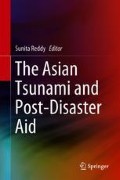Abstract
This chapter highlights the importance of studying social interfaces in the contexts of humanitarian crisis situations such as the Asian tsunami. Humanitarian response and recovery processes are characterized by the interface of different social actors with diverse values, interests, knowledge, and power. During such social encounters, social interfaces are manifested in the form of conflicts or cooperation between those actors affected by the disaster and those actors responsible for humanitarian aid. The chapter also reflects on the processes of continuity and change enforced by diverse outside actors, such as development practitioners and the State, on the day-to-day life events of people affected by disasters. By illustrating the case of fisherfolk in Tamil Nadu, this chapter emphasizes the need to revisit vulnerability reduction from a people-centred perspective. Pointing out that social situations in post-disaster settings are characterized by the interplay between very dynamic local cultures and static formal institutions, further complicated by issues of power, this chapter argues that rehabilitation and recovery programmes can be effective only if there is a restructuring of power, and there are mutually agreed upon norms and understanding between the different actors involved.
Access this chapter
Tax calculation will be finalised at checkout
Purchases are for personal use only
Notes
- 1.
It has to be noted that land use changes in many coastal regions were visible several years before the tsunami, due to growth of the real estate market and tourism. However, in most fishing villages, the ‘common pool’ nature of seashore and adjoining open spaces prevailed.
- 2.
It needs to be understood that many of the poor among the non-traditional fishing communities were the worst affected by the tsunami. Many among them have lost their livelihoods, equipment, and other resources, and these communities were not given any priority in rehabilitation. From the perspective of these communities, the fisherfolk unions have snatched away a larger share of their due benefits. The argument that this paper proposes is that recovery interventions have intensified the conflicts between different resource users. In addition, neither have the root causes of vulnerability been addressed in any of the cases.
References
Berke, P., J. Kartez, and D. Wenger. 1993. Recovery after disaster: achieving sustainable development, mitigation and equity. Disasters 17 (2): 93–109.
Biswas, N. 2007. Blue battle lines. In miles 2 go: Tsunami, rehabilitation, future, ed. M. Martin and S. Sivaraman. New Delhi: Indiadisasters.org.
Chairetakis, A. 1992. Past as present: History and reconstruction after the 1980 earthquake in campania, Southern Italy. Paper presented at the 51st annual meeting of the society for applied anthropology, Memphis, TN.
Chaudhry, S. 2007. Two years, still waiting. In miles 2 Go, ed. M. Martin and S. Sivaraman.
Cleaver, F. 2001. Institutional bricolage, conflict and cooperation in usangue, Tanzania. IDS Bulletin 32 (4): 26–35.
Gadgil, Madhav and Ramachandra Guha. 1995. Ecology and equity: The use and abuse of nature in contemporary india. New Delhi: Penguin Books.
Giddens, Anthony. 1984. The constitution of society: Outline of the theory of structuration. Cambridge: Polity Press.
Jentoft, S. 2000. The community: A missing link in fisheries management. Marine Policy 24 (1): 53–60.
Kurien, J., and T. Achari. 1994. Overfishing and the coastal commons: Causes and consequences. In social ecology, ed. R. Guha. New Delhi: Oxford University Press.
Long, Norman. 2001. Development sociology: Actor perspectives. London and New York: Routledge.
Martin, M. and S. Sivaraman (eds.). 2007. miles 2 go: Tsunami, rehabilitation, future. New Delhi: Indiadisasters.org.
Platteau, J-P. 1984. The drive towards mechanisation of small-scale fisheries in kerala: A study of the transformation process of traditional village societies. Development and Change 15 (1): 65–103.
Rubin, C., M. Saperstein, and D. Barbee. 1985. Community recovery from a major natural disaster. Monograph No. 41, Boulder: University of Colorado.
Salagrama, V. 2001. Coastal area degradation on the east coast of india: Impact on fishworkers. Paper presented at the forging unity: Coastal communities and the indian ocean’s future conference, October 9–13, Chennai, India.
Samal, K.C., and S. Meher. 2003. Fishing communities on chilka lake: Comparative socio-economic study. Economic and Political Weekly 38 (31): 3319–3325.
Santha, D.S. 2007a. State interventions and natural resource management: A study on social interfaces in a riverine fisheries setting in Kerala, India. Natural Resources Forum 31 (1): 61–70.
Santha, D.S. 2007b. Conflicts in fish trade: A study among the riverine fishing communities in Kerala, India. ISA E-Bulletin 8: 22–35.
Sivaraman, S. 2007. Apocalypse Here and Now. In miles 2 go, ed. M. Martin and S. Sivaraman.
Sunil, D.S. 2007. Culture, formal institutions and natural resource management: A study among the riverine fishing communities in Kerala, South India. Doctoral dissertation, Chennai: Indian Institute of Technology, Madras.
Wisner, Ben, Piers Blaikie, Terry Cannon, and Ian Davis. 2004. At risk: Natural hazards, people’s vulnerability and disasters. London and New York: Routledge.
Author information
Authors and Affiliations
Corresponding author
Editor information
Editors and Affiliations
Rights and permissions
Copyright information
© 2018 Springer Nature Singapore Pte Ltd.
About this chapter
Cite this chapter
Santha, S.D. (2018). Social Interfaces in Disaster Situations: Analyzing Rehabilitation and Recovery Processes Among the Fisherfolk of Tamil Nadu After the Tsunami in India. In: Reddy, S. (eds) The Asian Tsunami and Post-Disaster Aid. Springer, Singapore. https://doi.org/10.1007/978-981-13-0182-7_4
Download citation
DOI: https://doi.org/10.1007/978-981-13-0182-7_4
Published:
Publisher Name: Springer, Singapore
Print ISBN: 978-981-13-0181-0
Online ISBN: 978-981-13-0182-7
eBook Packages: Social SciencesSocial Sciences (R0)

